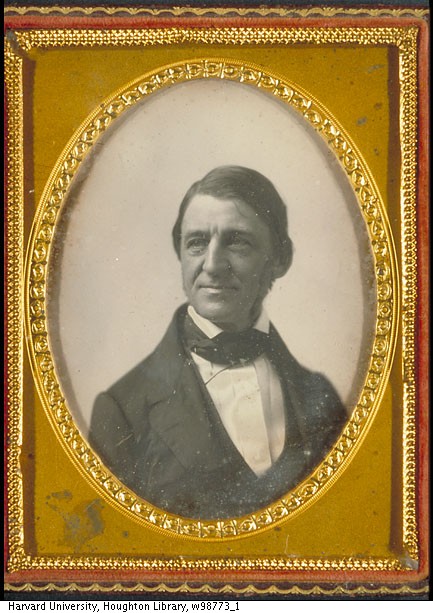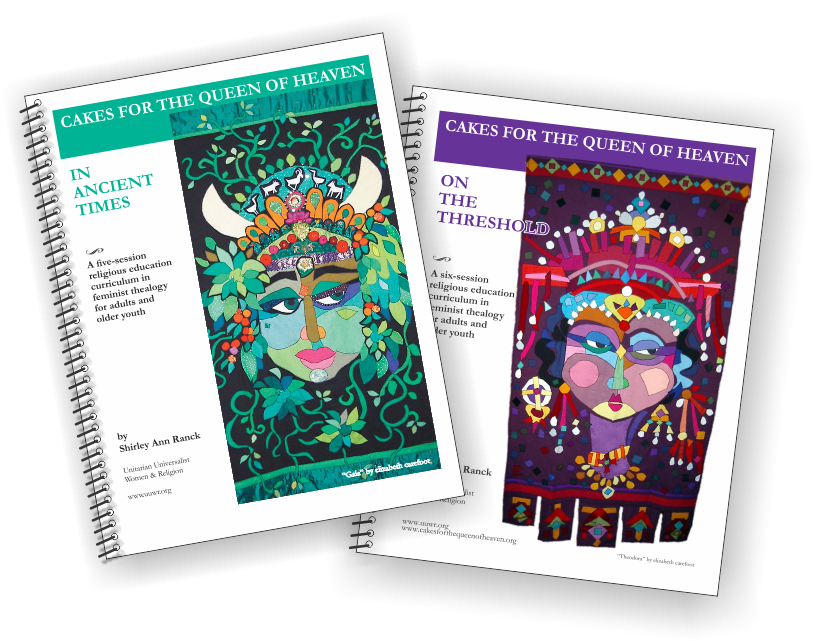A Conversation at the Old Manse Between Margaret Fuller and Edgar Allen Poe
The Old Manse Premiers:
Edgar A. Poe and Margaret Fuller: A Conversation
August 19, 7 pm
The year is 1845 and Margaret Fuller (1810-1850), portrayed by Jessa Piaia, and Edgar A. Poe (1809-1849), portrayed by Rob Velella, are at the height of their literary careers. The pair exchange gossip, talk about Transcendentalism, and discuss their recently published works, "Woman in the 19th Century" and “The Raven,” at Concord’s Old Manse. Presented as a dramatic reading, the program is part of the Margaret Fuller Bicentennial Celebration "Conversations Series,” and is appropriate for audiences age 10-adult. Poe and Fuller will converse for about 35 minutes, with an informal Q&A and refreshments to follow. Admission is $5 per person.
The premier performance of this new dramatic piece will take place under the Manse tent overlooking the Concord River. Bring your own blanket or lawn chairs, or arrive early with your own picnic to enjoy on the lawn. Light dessert will be served following the conversation, or visitors may choose to browse our air-conditioned bookstore and save 10 - 50% off during our storewide sale in honor of this event.
Special Margaret Fuller Tours of the Manse will be offered on August 19 at 4, 5, 6 and 8 pm. Tour this 1770’s home while learning about Fuller’s visits with Nathaniel and Sophia Hawthorne while they lived at The Manse in the 1840’s. Admission is $8. Trustees of Reservations Members $4. Reservations suggested. Call 978.369.3909.
Historic Background and Biography - Writer, intellect, and teacher, Margaret Fuller was the first editor of The Dial, the quarterly Newsletter of the Transcendentalists. After publishing Woman in the 19th Century and Summer on the Lakes in 1844, Horace Greeley hired her as editor and literary critic of his New York Daily Tribune. In 1846, Fuller embarked to Europe as the first female foreign correspondent of a daily newspaper. En route home four years later, she perished at sea in a shipwreck off Fire Island along with her husband Giovanni Ossoli and their son Angelo. A cenotaph commemorating her accomplishments stands at Mount Auburn Cemetery.
Jessa Piaia studied performance at London’s Oval House Theatre. Her Women in History Programs depict the accomplishments, struggles, and contributions of American women (http://www.womeninhistoryprograms.com). Since 1985 she performs at educational institutions, museums, libraries, and cultural organizations throughout New England. Recipient of Massachusetts Foundation for the Humanities grants, and from local arts lotteries, her many successes include "Meet Isabella Stewart Gardner: America’s First Patroness of the Arts," and "From Suffragist to Citizen: A Conversation with Susan B. Anthony & Eleanor Roosevelt."
Though known today mostly for his tales of the macabre and mystery, Edgar A. Poe was one of the most influential literary critics of his day. His editorial duties for The Southern Literary Messenger, Graham's Magazine, and the Broadway Journal brought him into contact with most of the literary figures of the period. Despite Poe’s popularity, he was never financially successful and died destitute and mysteriously in Baltimore at the age of 40.
Literary historian Rob Velella has lectured at historical sites, libraries, and colleges across the East Coast. Most recently he presented papers at the Poe Studies Association (2009) and the Hawthorne Society (2010), and served as guest curator for "Margaret Fuller: Woman of the Nineteenth Century" at Harvard's Houghton Library and as research associate for "The Raven in the Frog Pond: Edgar Allan Poe and Boston" for the Boston Public Library. As well as performing as Henry Wadsworth Longfellow and Nathaniel Hawthorne, Velella, also maintains the American Literary Blog www.americanliteraryblog.blogspot.com.
For more information, contact The Old Manse at 978.369.3909. Located at 269 Monument Street, Concord, MA. Visit our website www.oldmanse.org. Email oldmanse@ttor.org The Old Manse is a property of the Trustees of Reservations www.thetrustees.org.
This event is part of the Bicentennial’s Conversations Series, supported by a grant from Mass Humanities and modeled after the “Conversations” Margaret Fuller offered for women (and later men) in Boston in the late 1830s and early 1840s. The event is co-sponsored by the Margaret Fuller Bicentennial Committee and is part of a year-long series of events celebrating Margaret Fuller’s life and work. For a complete list of the other programs, please visit: www.margaretfuller.org.
Sermon Award Winner
First Parish of
Sunday, May 9, 2010 – Mother’s Day
Rev. Katie Lee Crane, preaching
A Conversation with Margaret Fuller
Very early, I knew that the only object in life was to grow.
- Memoirs of Margaret Fuller Ossoli (1852)
Listen to the sermon now!
OPENING WORDS Rev. Katie Lee Crane
Today, we are celebrating Margaret Fuller’s birthday. She was born on May 23rd 200 years ago.
She grew up to be one of our most famous Unitarians. Ralph Waldo Emerson and Henry David Thoreau were close friends. She was the first to do a lot of things girls and women had never done before.
Father wanted her to have same education as a boy. – but in 1810, there were no schools for girls (at least where girls could learn the same things as boys).
Margaret learned to read when she was three. Books were her best friends. She read so much and so long that she got headaches and eye strain, shoulders hunched.
Margaret didn’t play with other children; she had a hard time making friends. She wanted to fit in but she felt different.
For example, she loved to debate things and speak up about what was on her mind, but everyone thought she was showing off. People made fun of her.
Imagine beginning your day like this: At 15 Margaret Fuller wrote: “I rise a little before five, walk an hour, and then practice on the piano, till seven, when we breakfast. Next I read French—Sismondi’s Literature of the South of
Because of people like her, lots of things ARE possible for us today. Thank you… and Happy Birthday, Margaret Fuller.
UNISON CHALICE LIGHTING
If you have knowledge, let others light their candles at it.
If you have knowledge, let others light their candles in it.
If you have knowledge, let others light their candles with it.
-- attributed to Margaret Fuller (also to Thomas Fuller, her father)
READING
an excerpt from the sermon, Margaret Fuller: Adieu and Love as You Can, by the Rev. Christine Hillman[2].
….Margaret Fuller was not one-dimensional! She struggled and wrestled, met the issues of the day head on and made mistakes, alienated people close to her, alienated the nation for awhile, left the country to escape the mess. She wasn’t an easy woman. But she wouldn’t have been Margaret Fuller if she had been a simple person. She wouldn’t be a model if she had been simply a woman of her time. [She was] a complex woman, a person like you and me, never simple.
…She led a remarkably intellectual life, more academic than most Americans then or now, far more academic than any other girl of her time. Her father’s challenge was the force behind the education she received. He wrote from his Senate office in
[But] Her father … couldn’t teach her what to do with her genius or her education. Margaret didn’t know what to do with it either. One biographer said of Fuller that she was “living a problem the more oppressive and insidious because she couldn’t name it.”[3] It was a suffering that contributed to intense and pervasive migraine headaches as well as to chronic insomnia throughout her life. Margaret Fuller was not perfect but she kept on. She suffered but didn’t surrender. Her prayer was this: “Give me truth, cheat me not by illusion.”[4]
Perhaps it was because of this prayer that she gathered young women for “Conversations.” For five winters Margaret and twenty to twenty-five young women met over tea in the parlor of a friend to discuss important philosophical questions of the day. She used her intellect and education; she handed on its importance to other young women, so that they would gain access to a life of the intellect, so that they would not be cheated by illusion. Perhaps she hoped to find in that group of women someone she could genuinely talk to. In her journal she wrote: “I must take my own path, and learn… without being paralyzed for today. We need great energy, and self-reliance to endure.”[5]
Margaret Fuller was not a perfect woman; she made mistakes. …
She struggled… and wrote in a letter:
For all the tides of life that flow within me, I am dumb and ineffectual….
With the intellect I always have, always shall, overcome; but that is not the half of the work. The life, the life! O, my God! Shall the life never be sweet?[6]
…When Margaret Fuller was twenty-six years old she met Ralph Waldo Emerson, then thirty-four. He introduced her to Transcendentalism, for her a religious affirmation of the life of the mind. For several years Fuller was editor and literary critic for the Transcendentalist magazine, The Dial. She absorbed Transcendentalism—and grew beyond it…. Transcendentalism, with its too often emphasis on the life of the mind, was not enough for her.
She entered the fullness of her public life in
[She convinced
In
hospital director on a small island in the
After the war, Margaret, her husband and their son embarked for the
…Her last letter to Quaker friends, written June 3, 1850, ended [this way]: “with most affectionate wishes that joy and peace may continue to dwell in your house, adieu and love as you can.”[8]
READING from Margaret Fuller, 1847, a poem by Amy Clampitt[9]
[text pending permission to publish]MUSICAL INTERLUDE New Worlds Manifest
Adapted from the words of Margaret Fuller by Ed Thompson
Music composed by Laura Halfvarson Jump
We seek in nature and in art for ways to comprehend the meaning that our life enfolds, what makes us break or bend. Within each leaf and brush of paint our traits we apprehend; and in these patterns we can find a life that’s without end. A life that’s without end.
All women and all men alike may freely use the mind, and thus from thoughtless mannered ways a truer pathway find. But also freely let’s employ imagination’s part that dwells inside of every soul; and makes of life an art. And makes of life an art.
No matter what our circumstance, our nature is to grow and in that growth we may discern the gifts we can bestow. Whatever be your calling do! Sincerely, and with zest; and in that work may we then find the holy manifest. The holy manifest.
And on this journey share the thoughts that beckon, old or new; surpassing challenge, strive beyond: our lives will be renewed. With courage then, may we reach out to aid the oppressed and weak. And in that struggle manifest the justice that we seek. The justice that we seek.
SERMON A Conversation with Margaret Fuller Rev. Katie Lee Crane
Happy Mother’s Day, Margaret. So few people remember you as a mother. But today, I wonder how it was for you – to find love and have a child when, frankly, no one expected either of you – including you yourself.
I can’t get this image out of my mind – you, sitting there on the deck of the ship, almost certainly knowing what was likely to happen. It’s a mother’s worst nightmare. Henry David Thoreau described the scene in a letter to Ralph Waldo Emerson less than a week after you died.
The ship struck at ten minutes after four am, and all hands, being mostly in their nightclothes, made haste to the forecastle, the water coming in at once. There they remained; the passengers in the forecastle, the crew above it, doing what they could. Every wave lifted the forecastle roof and washed over those within. The first man got ashore at nine; many from nine to noon. At flood-tide, about half past three o’clock, when the ship broke up entirely, they came out of the forecastle, and Margaret sat with her back to the foremast, with her hands on her knees, her husband … already drowned. A great wave came and washed her aft. The steward had just before taken her child and started for shore. Both were drowned.
I cannot fathom how you must have felt in those final minutes. You were only 40. You were coming home with a husband and a son. Your manuscript of the Italian Revolution was complete. You’d never been so happy, or so you wrote to your mother. And you lost everything within sight of the shore.
You were not the same person who left four years earlier. Ironically, you had found yourself in the middle of a war zone. Finally, you belonged. Finally the powerful hunger of your intellect was no longer at war with your imagination and emotions; they seemed to be living in harmony. Or so I’d like to believe.
But I wonder if that’s true? I read somewhere that you were afraid to come home to
American poet Amy Clampitt described how she imagined you just before you sailed.
"What would Carlyle [who’d called you an old maid], what would straightlaced
Horace Greeley, what would fastidious
Nathaniel Hawthorne, what would all of
all
say now?"
Would you ever fit in back home? With an Italian husband 10 years your junior and a child? But you had no choice. You needed help and stability and an education for your little Nino.
I can’t imagine what it was like to hand him over to that steward and the stormy sea. What went through your mind those last minutes – did you see your life pass before you? Did you lament the inevitable loss? Or was there some poetic justice that you and the ones you most loved would die together before life’s realities interfered with your happiness? We will never know. But I sit there with you now… and wonder.
I met you in 1966, in Dr. Dean’s American Literature class. “Write about one of the Transcendentalists,” he said, “choose one from this list.” By the time the list made its way to me, there was no one left whose name I recognized. No Emerson. No Thoreau. But, there was a woman – you. Off I went to the library to do my research only to discover nothing – absolutely nothing – about you. You were occasionally mentioned in tomes about the others, but there was nothing specifically about you. I discovered that your papers were at Houghton Library at
Still I learned enough to be fascinated. Some years later, I discovered a biography by Mason Wade, published in 1941.[10] A friend found it for me in a used bookstore. I devoured it. I related to you in so many ways. The child who was smart – for a girl. The overweight girl who had more books than friends; the same girl, who, when she spoke up, people said she was “showing off.”
Your intellect dominated and yet you yearned for emotional release. You seemed incapable – then – to imagine that they might both be important. You had this drive to grow, this desire to know life as fully as possible.
I thought of you as a teacher. Someone whose experience was more like mine than most others I knew. You were to me what Georges Sand[11] was to you – what we call a role model. It was more than a hundred years since you launched your famous Conversations for women, yet women of my generation were stirring again, trying to break out of the mold we had been forced into. Like you, we were preoccupied about our identity. Like you, we were driven to convince others that it was possible to be a woman while engaging in the kinds of intellectual pursuits thought to belong only to men. And, yes, like you, we believed women had the right to choose motherhood and marriage instead of having it be the expectation.
I wonder now what it was like for you to be courted by Ossoli? At home they say you had literally driven off suitors. You declared you had no expectation of marrying. What made you open your heart to him? He was neither your age nor your intellectual equal. What made it impossible to remain “unconscionably chaste?” I have to believe that the mores of
But that’s jumping ahead. In 1836 you met Ralph Waldo Emerson and he invited you into the Transcendentalist circle. There you found a religious movement that affirmed the mind – but was so much more than that. It introduced intuition into the mix. It suggested that truth could be revealed through one’s own experiences – literally by seeing or hearing or touching something that moved you to a kind of knowing that was not of the intellect. You’d had such an experience at 21. You knew first hand what it meant.
This new perspective invited you to seek meanings in nature, in art, in imagination. Like Emerson, you’d read Goethe; you were drawn to the mystical. Transcendentalism seemed to offer you a new freedom. It was adventurous. It gave you space to explore who you were.
It was so different from the Unitarianism of your childhood, where scripture was considered the only authoritative source of inspiration. This new religious movement was so expansive.
Learning about Transcendentalism and about you in 1966 were surely my first steps toward discovering a new religious home in Unitarian Universalism. As I learned more and eventually joined this religious community, I remember saying “This is a religion big enough to hold me!” It sounds self-aggrandizing now, but it was so liberating. To me, there is so much that is holy. One doesn’t just find it in a church, or a holy book, or even an ancient ritual re-enacted everyday. I see holiness everywhere, often in some very unlikely places. Discovering Unitarian Universalism was, for me, the bridge that connects intellect and intuition. It’s been opening my mind and heart ever since.
In 1839 you introduced your famous Conversations. You invited women intellectuals and activists to meet together. In 1966, we had consciousness-raising groups. Same thing. We brought women together to learn and to share their experiences. Let’s face it: you started those Conversations because the men wouldn’t invite you to join theirs. You wanted friends and intellectual stimulation. And you needed money (part of that time you were homeless). A woman wasn’t allowed to lecture in public so you called your gatherings “conversations,” arguing: “There’s no law about women having a conversation!
Frankly, you were self-centered. Emerson quoted you as saying: “I know now all the people worth knowing in
You were intense and complicated. They called you idiosyncratic, mercurial, inspiring, alienating, and tormented. Those who knew you acknowledge you to be brutally honest both about yourself and others. One of your biographers[13] claimed you had an uncanny ability to learn from mistakes and misfortune. She admired your skill and courage in naming your feelings and speaking your mind. You could unblinkingly acknowledge pain.
I wonder about the pain you felt on the deck of that ship. Or how you felt when you found yourself in
You learned and changed so much even before you set sail for
You began to understand how everyone was equal – the women in prison, the women in your circle of friends. African Americans. Native Americans. You dared to speak out publicly for education for all and loudly against slavery. Earlier, you’d insisted that abolition be off the table in your Conversations. Now it was a cause célèbre. Justice, for you, meant equal rights and equal opportunities. I can’t imagine how you’d feel if you knew we’re still fighting for the some of the same things.
You wrote your book – Women in the Nineteenth Century. But you weren’t prepared for the response. A few said it was bold. Most said things like indelicate, horrendous. It certainly got a response. Much of it negative.
Your own response was to feel even less at home in the
The next year, you died.
As we celebrate the bicentennial of your birth, I want to say “thank you.” Dr. Dean was my Emerson and you, my mentor. Both of you showed me possibilities I had never before imagined. I think back to how radical it was for Transcendentalism to suggest that one might be inspired by something other than scripture. Ironically, it was still radical for me in 1966. When I read that my own experiences could also be a source of inspiration – I felt affirmed. The walls of my traditional religious upbringing crumbled and I began to build myself a new temple as big as the earth and the universe itself.
Today, we Unitarian Universalists list many sources of inspiration. One, direct experience of transcending mystery and wonder, comes right out of Transcendentalism. But it is another where I lovingly inscribe your name: words and deeds of prophetic women and men which challenge us to confront powers and structures of evil with justice, compassion, and the transforming power of love. It is your story that helped me to find my way.
We don’t have saints in our religion. Though I admit, in those very early years you were a bit of a saint for me. Now, you are all the more important to me because you were so human. You loved and you suffered. You were a truth-teller and justice-seeker in the public sphere; you were sometimes lost and lonely in your private world. You were quirky and smart and frightened, not because you were perfect, but because you weren’t. It is all of who you were – and weren’t – that is inspiring to me. You were determined to learn and grow and seize life. And you did. I want no more or less than that for myself.
Thank you, Margaret. Happy Mother’s Day… and Happy Birthday.
CLOSING WORDS
The Fuller family erected a monument to Margaret’s memory at
[1] Bell Gale Chevigny, The Woman and the Myth, (Old Westbury, CT: The Feminist Press, 1976) p.55.
[2] The full text of Rev. Hillman’s sermon may be found at the Margaret Fuller Bicentennial website: www.margaretfuller.org
[9] Amy Clampitt, “Margaret Fuller, 1847,” Archaic Figure, New York: Knopf, 1987.
[10] Mason Wade, Margaret Fuller: Whetstone of Genius, (New York: Viking, 1941).
[11] Aurore Lucile Dupin, later Baroness Dudevant (1805-1876), a French novelist who used the pseudonym George Sand.
“Why Margaret Fuller Matters” Traveling Display
The author and designer of the display is Bonnie Hurd Smith, graphic designer, public historian, and author/publisher of books on Judith Sargeant Murray and other historical subjects.
Introduction
Author, editor, journalist, literary critic, educator, friend of the Transcendentalists, social commentator, women's rights advocate, and political revolutionary, Margaret Fuller left an indelible mark on Western civilization during her short forty years.
Today we consider Margaret Fuller one of the guiding lights of the first wave of feminism. She helped educate the women of her day by leading a series of Conversations in which she empowered women to read, think, and discuss important issues of the day. She influenced generations to follow through her classroom teaching, groundbreaking writings, especially her landmark book Woman in the Nineteenth Century, and through her personal example of independence and courage.
Fuller's bold public voice began to emerge in New England, but in her work for the New-York Tribune, which she transplanted to Europe, Fuller's calls for liberty and equality for all people internationally established her as a transcontinental literary ambassador.
Among her accomplishments:
- First American to write a book about equality for women
- First woman foreign correspondent and first woman war correspondent to serve under combat conditions
- First woman journalist for Horace Greeley's New-York Tribune, and first woman literary editor of a major American newspaper
- First editor of the Dial, the Transcendentalist journal, making her the first woman in America to edit an intellectual publication
- First woman literary critic who also set literary standards for American writers
- First woman to enter the Harvard College library to pursue research
Margaret Fuller matters because her all-encompassing, inspiring, and still unrealized vision--aimed at the future--challenges us to continue her work and honor her legacy.
Quote:
From Woman in the Nineteenth Century:
"If you ask me what office women may fill; I will reply--any. I do not care what case you put; let them be sea-captains if you will ... We would have every arbitrary barrier thrown down. We would have every path laid open to woman as freely as to man ... Can we wonder that many reformers think that measures are not likely to be taken in behalf of women, unless their wishes could be publicly represented by women?"
Foundations
Sarah Margaret Fuller, born on May 23, 1810, in Cambridge, Massachusetts, was the oldest child of Timothy Fuller, a Harvard-educated attorney, and Margarett Crane Fuller. With the death of an infant sister, young Margaret was an only child for several years and the center of her father's attention in particular.
Timothy Fuller planned a rigorous course of study for his daughter. "To excel in all things should be your constant aim," he told her. "Mediocrity is obscurity."
By the time Margaret was 3 1/2 years old, Timothy was teaching her how to read and write; at 4 1/2, he taught her arithmetic; just before the age of 5, she learned English and Latin grammar. Even when Timothy Fuller was elected to the U.S. Congress and spent many months in Washington, D.C., he directed Margaret's studies by mail. Margaret also read voraciously: political philosophy, great European authors and playwrights, ancient and recent history, travel, biography, and even novels -- much to her father's consternation.
When Timothy Fuller was at home, father and daughter conversed in the evenings about what she was learning. "In the process," biographer Joan von Mehren explains, "Margaret developed a well-stored mind, a remarkable facility with the spoken word and foreign languages, and the exhilarating sense that she was very alive under tension."
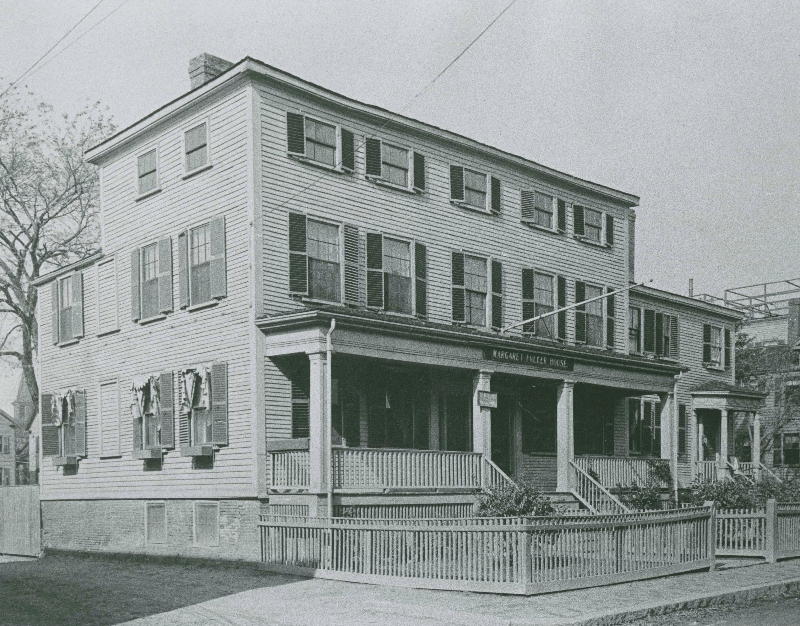
Fuller’s childhood home, 71 Cherry Street, Cambridge
(Cambridge Historical Commission)
Margaret's father stressed analytical skills, logic, and "the correct use of language, "according to von Mehren. Timothy Fuller's goal was to have his daughter develop "a secure and favored place in an ordered republican society" that was consistent with his Enlightenment values.
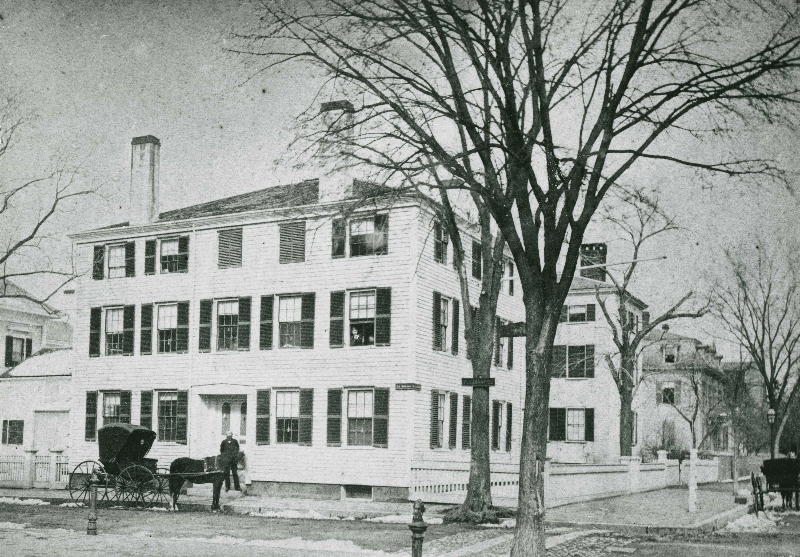
The Port School, 760 Massachusetts Avenue, Cambridge
(Cambridge Historical Commission)
At age 9, Margaret attended the Cambridge Port Private Grammar School ("The Port School") whose master was a Harvard graduate. By age 10, she had command of the standard classics in translation and was beginning to learn French. She was known as the "smart one," according to classmate Oliver Wendell Holmes. The following year, Margaret attended Dr. Park's Boston Lyceum for Young Ladies where she was ridiculed for her "country ways." She was now studying Italian, French, and geography, and attending dancing school.
Fearing their daughter's potential "unmarriageability,” the Fullers sent Margaret for a brief time to Susan Prescott's more traditional Young Ladies' Seminary in rural Groton, Massachusetts. But she soon returned to The Port School to study Greek and Latin. Eventually, at the age of 15 and with her father's assistance, Margaret Fuller created her own course of self-study, which included lessons with the author Lydia Maria Francis (later, Child).
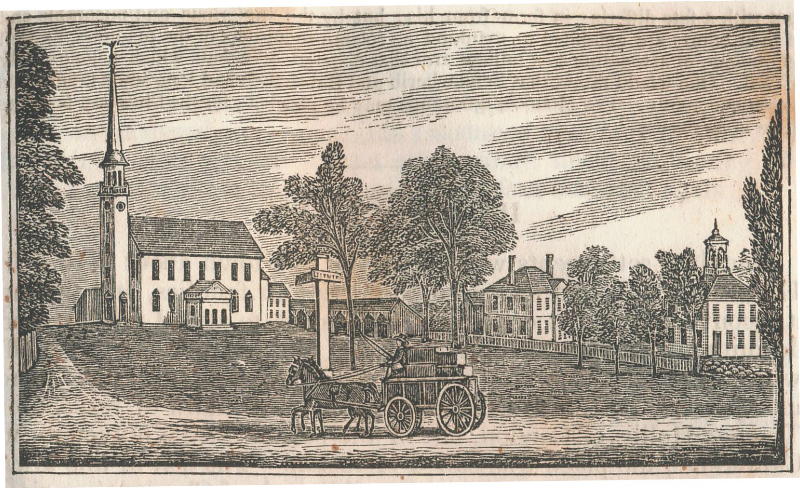
Groton, Massachusetts
Margaret became friends with a group of young Harvard students who were caught up in a heady time of intellectual, literary, and theological activity at the college. German philosophy, literature, and poetry were the "craze," and many of these young men (James Freeman Clarke, Frederic Henry Hedge, William Ellery Channing) were preparing for leadership roles in the Unitarian church. Margaret borrowed books from them, and invited them home for lively exchanges of ideas.
Like her Harvard friends, Margaret discovered the German philosopher and literary giant Johann Wolfgang von Goethe, regarded as a leading thinker by American Transcendentalists. In 1833, when the Fuller family moved to a farm in Groton, Massachusetts, Margaret felt terribly isolated from Cambridge and Boston, but she viewed her time there as her "graduate school" and began to study German in earnest.
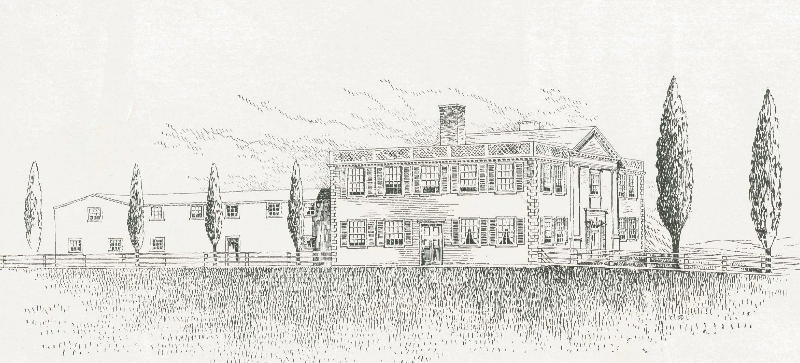
The Dana Mansion
Teaching and Self-education
Margaret Fuller's teaching career began at home, where she was responsible for the early education of her younger siblings. In Groton, she began earning money by adding neighborhood children to her home-based classroom.
While in Groton, Fuller also began writing for publications. Her first article of literary criticism (an emerging field in America), appeared in 1834 in her friend George Bancroft's Boston Daily Advertiser. She wrote literary and dramatic criticism, and translated Goethe for James Freeman Clarke's Western Messenger.
Fuller began to understand teaching young people and publishing articles as part of her larger role in life as a public educator. As Joan von Mehren explains, "Teaching was natural to her, and she would, in fact, never cease being a teacher in one guise or another."
When their father died suddenly in 1835, Margaret wrote to her brother Richard, "Nothing sustains me now but the thought that God ... must have some good for me to do." She was considered the de facto head of her family now, and their finances were meager. Fuller needed paid work, and an opportunity surfaced the following year in Concord, Massachusetts. There, during her first visit to Ralph Waldo Emerson's home, she met Bronson Alcott whose innovative Temple School in Boston would soon be without a teacher due to Elizabeth Peabody's resignation.
While Fuller waited for Alcott's job offer, she decided to move to Boston to start language and literature classes for women in German, Italian, and French. Before she left Concord, Emerson "kindly" identified "lapses" in her education. He steered Fuller toward the German and British philosophers and writers she would have studied if she had been able to attend college.
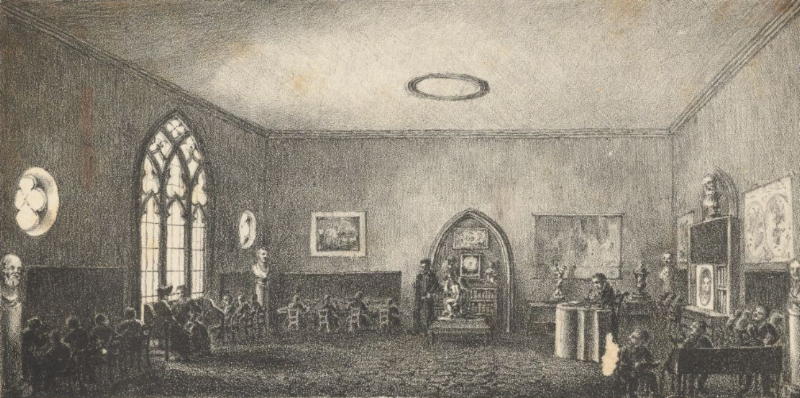
Bronson Alcott’s Temple School (Houghton Library, Harvard
University. Purchased with the Amy Lowell Fund, 1992)
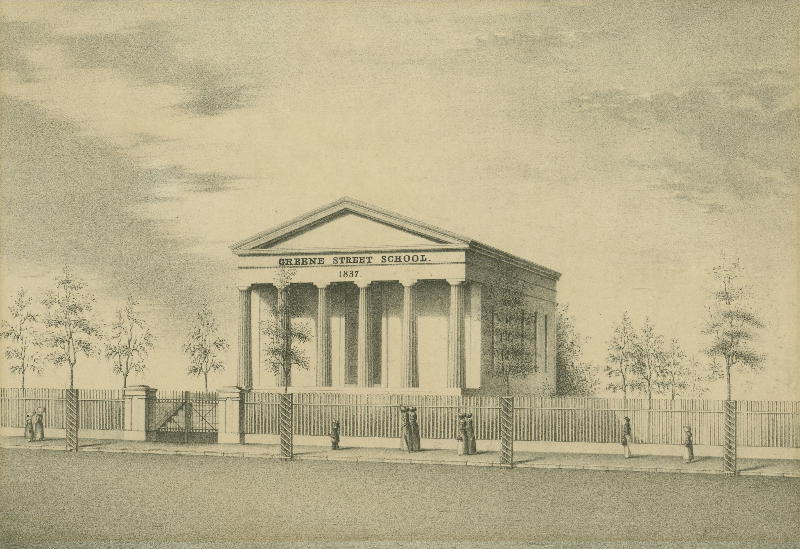
Greene Street School (Rhode Island Historical Society)
Fuller's time at the Temple School was short due to Alcott's controversial methods and the eventual closing of his school, but while there, she taught Latin, French, Italian, and kept records of the students' "conversation classes." In 1837, once again in need of work, Fuller accepted a well-paid position at Hiram Fuller's Greene Street School in Providence, Rhode Island, where she was put in charge of 60 students. She taught Latin, composition, elocution, history, natural philosophy, ethics, and the New Testament. Fuller's students described her as "strict and demanding, witty and authoritarian, at times unreasonable but always formidable, challenging, and impressive." Students were drawn to the school because of Fuller's reputation.
In the evenings, Fuller taught German language classes for women and men and worked on a biography of Goethe. She joined the intellectual Coliseum Club where she delivered her first public speech on "the sorry relation of women to society."
Earlier, during a visit to Concord, Fuller participated in gatherings of the "Transcendentalist Club"--the first time women were allowed as members in a "major male intellectual society," according to biographer Charles Capper. Before leaving Providence due to her failing health, Fuller observed, "I am not without my dreams and hopes as to the education of women."
Returning to Boston, Fuller made plans to hold what she called "Conversations" for women at Elizabeth Peabody's bookstore on West Street. Her initial purpose was not at all political. Instead, Fuller was interested in exploring two fundamental questions: What were we born to do? How shall we do it? These were questions "which so few ever propose to themselves 'til their best years are gone by." At the very least, she hoped to provide "a point of union to well-educated and thinking women" where they could satisfy their "wish for some such means of stimulus and cheer, and ... for a place where they could state their doubts and difficulties with hope of gaining aid from the experience or aspirations of others."
Margaret Fuller's lucrative Conversations continued for five years and attracted approximately 200 students. Among them were some of the most prominent women intellects, authors, and reformers in New England including Julia Ward Howe, Lydia Maria Child, and Ednah Dow Cheney. Eventually, given the heightened political activity in Boston on the subjects of slavery and women's rights, Fuller's Conversations took a decidedly political turn.
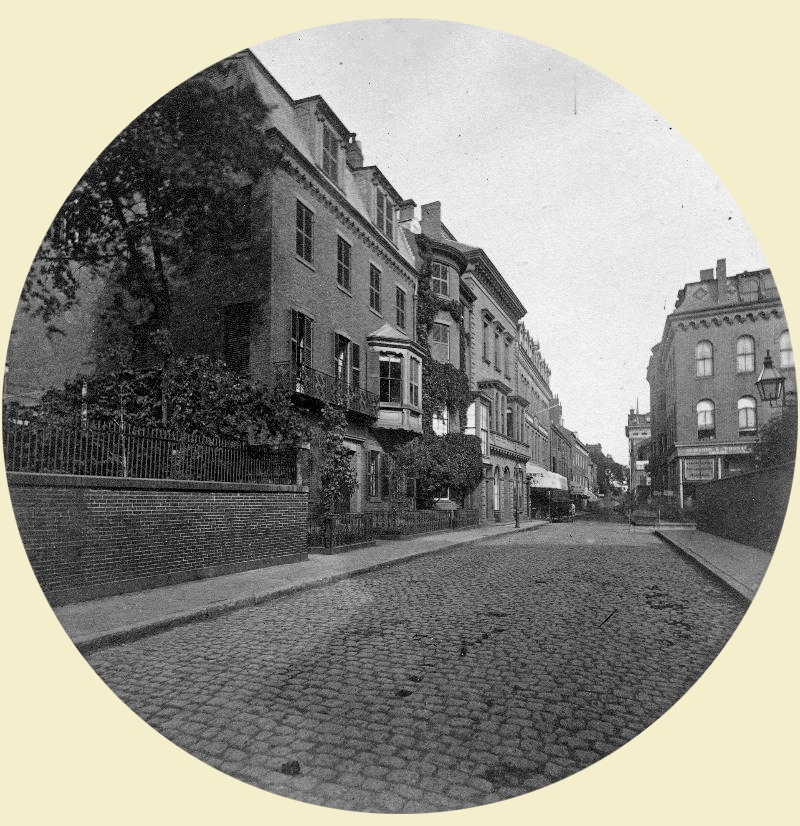
13-15 West Street, Boston (left) (The Bostonian Society)
Emerging Voice
In 1840, when Margaret Fuller agreed to serve as the first editor of the Dial at Ralph Waldo Emerson's request, she propelled herself even further into the public eye. While Fuller shunned the "Transcendentalist" label for herself, the Dial provided a vehicle for Transcendentalists to explain and defend themselves from criticism and misinterpretation. The Dial served as a forum for new authors and new ideas. Fuller saw the publication as “a perfectly free organ ... for the expression of individual thought and character, [one that would] not aim at leading public opinion, but at stimulating each man to think for himself."
Fuller solicited work from such writers (and friends) as Bronson Alcott, Frederic Henry Hedge, Caroline Sturgis, Ellery Channing, Henry David Thoreau, Theodore Parker, Elizabeth Peabody, George and Sophia Ripley, and, of course, Emerson. She also provided her own articles on literary and cultural criticism and biography. Fuller's 1841 article on Goethe brought her acclaim as a leader in American cultural thought, and perhaps prompted her first visit to Brook Farm, the Utopian Transcendentalist community in West Roxbury, Massachusetts, founded by the Ripleys.
|
Ralph Waldo Emerson |
Debut issue of the Dial, July 1, 1840 (Andover-Harvard Theological Library) |
One of the key areas where Transcendentalists and other reformers clashed was on the subject of social and political change. Should reform happen within the individual or by tackling institutions and taking radical action? At the time, Fuller shied away from joining any particular group, preferring to examine many sides. But her two-year stint as editor of the Dial set her on a path toward radicalism and shaping public opinion.
Due to the financial instability of the publication Fuller never received her promised payment for being editor, so in 1842 she resigned. Emerson told her, "You have played martyr a little too long alone: let there be rotation in martyrdom!" and she gratefully turned over the editorship of the Dial to him. Fuller spent time that summer traveling with friends in New England. In Boston, she continued her language classes and Conversations, which became increasingly political.
In an 1843 edition of the Dial, Emerson published the essay that would initiate the next phase of Fuller's public life. In "The Great Lawsuit: Man vs. Men and Woman vs. Women," she held up the egalitarian ideals of the American Revolution. Fuller pointed out that while these ideals did not yet apply to women, African Americans, and Native Americans, Americans had a "special mission" to strive toward a just social system -- and to assist others in the world who were initiating their own revolutions. Human freedom was a right, she asserted.
Fuller also threw out the ideology of "separate spheres" for women and men, instead addressing the conflicts between what was "male" and what was “female" within each person. She looked at gender roles in male and female friendships, and the laws and customs associated with marriage (subjects she also examined in her personal life as a single woman with male friends and married friends). She boldly exposed patriarchy and its effects.
Fuller's groundbreaking essay caught the attention of another outspoken literary reformer -- Horace Greeley, the publisher of the progressive New-York Tribune. He printed an excerpt of "The Great Lawsuit" in his newspaper in 1843.
Meanwhile, Fuller traveled to what was then considered the "western frontier" (Illinois and Wisconsin) with James Freeman Clarke, his sister, Sarah, an artist, and their mother, Rebecca, where she wanted to experience the American wilderness. She hoped to find instances of socially progressive communities far away from the East. Instead, what caught her attention were the consequences of the displacement of native peoples and the struggles of the settlers, especially the women, to survive difficult conditions.
Fuller saw the disparity between the promise of America and the reality of America, and the result was her 1844 book Summer on the Lakes, in 1843 -- an honest, first-hand account of conditions out west and a condemnation of U.S. policy. Biographer Charles Capper explains that she "[put] the region on the national literary and intellectual map and attract[ed] a national audience."
Summer on the Lakes was the first time Fuller used her own name in her work; the research she completed at Harvard made her the first woman to use Harvard's library (in Gore Hall).
Once again, Margaret's boldness caught the attention of Horace Greeley. He offered her a job in New York.
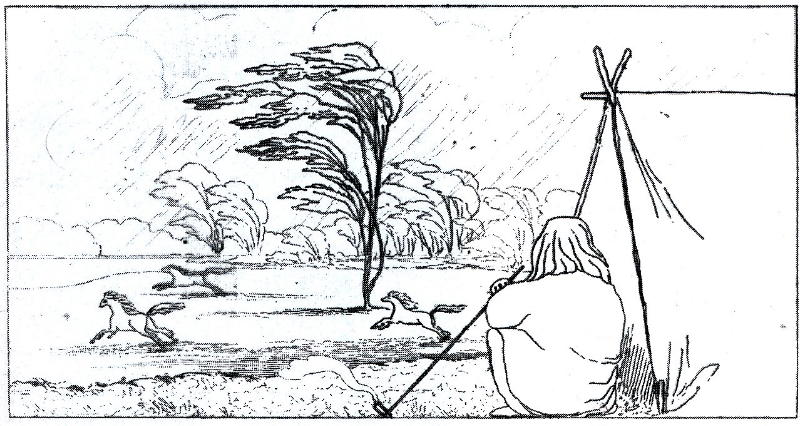
One of Sarah Clarke’s drawings that appears in Summer on the Lakes, in 1843
Public Voice

“In cities and small towns throughout New England, New York, the Great Lakes, and the Ohio Valley, farmers, mechanics, and small merchants read the weekly aloud to their families, loaned it to neighbors, and organized ‘Tribune Clubs’ to discuss its latest news and pronouncement on national and international affairs. ‘The Tribune comes next to the Bible all through the West,’ its roving reporter Bayard Taylor would soon brag to his boss, and considering the multiple times each copy was read and its articles reprinted in other newspapers, Taylor’s boast was almost an understatement.” —Charles Capper
Horace Greeley put Margaret Fuller's essays on Page One of his reform-minded newspaper, the New-York Tribune. She signed them with the symbol of a star, or an asterisk. Greeley paid Fuller the same salary as a man's, gave her a place to live when she first arrived, and encouraged her to write with "force." Fuller thus became the first woman in America to head the literary department of a major newspaper.
Fuller reviewed books (American and foreign), periodicals, musical events, concerts, lectures, and art exhibits. She visited and wrote about New York's "benevolent" institutions--prisons, hospitals, almshouses, insane asylums, homes for the blind and deaf. Now in a position to influence popular culture and social policy through first-hand observations, her urge to tell the truth and exceptional writing talent brought her fully into the public arena.
Greeley saw her as "a philanthropist, preeminently a critic, a relentless destroyer of shams and outward traditions."
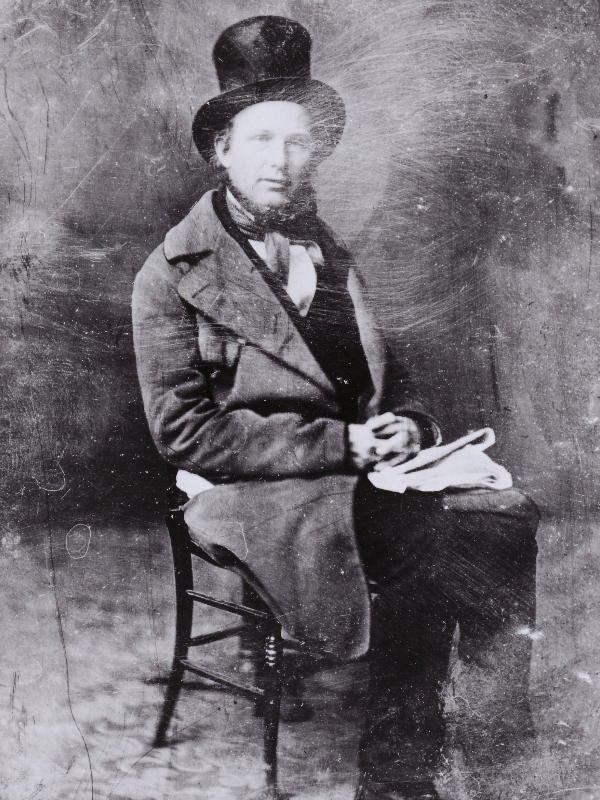 “Texas annexed, and more annexations in store;
“Texas annexed, and more annexations in store;
Slavery perpetuated, as the most striking new feature
of these movements. Such are the fruits of American
love of liberty! Mormons murdered and driven out, as
an expression of American freedom of conscience.
Cassius Clay’s paper expelled from Kentucky; that is
American freedom of the press. And all these deeds
defended on the true Russian grounds: ‘We (the stronger)
know what you (the weaker) ought to do and be, and it
shall be so.’” —Margaret Fuller, 1845
Fuller's social commentary included condemnations of the approaching war with Mexico, the annexation of Texas, and the expansion of slavery. As historians Judith Mattson Bean and Joel Myerson explain, "She realizes that a war would drastically reconfigure the nation's population and landscape, leaving a legacy of dispossession and ethnic conflict. Fuller's essays actively resist American imperialism with attempts to subvert racist American expansionist rhetoric ... [her] participation in this debate was significant for another reason: the war with Mexico played a critical role in her disillusionment with America ... she began to equate U.S. national policy with European despotism and imperialism."
America's national identity was in crisis in the 1840s. There were questions about American literary independence from Europe and the United States' responsibility to foreign revolutionaries. Bean and Myerson point out:
"In reviewing contemporary American literature, Fuller practices a democratic criticism that challenges writers to uphold ideals of liberty and equality. Her political essays also argue that America's principles of liberty and equality are endangered by American materialism, greed, and the desire for continental domination. She directs attention to the relation of dominant American society to the other, contending that American society is founded upon tolerance and upon recognition of universal human rights rather than domination by force."
In 1846, learning that her friends Marcus and Rebecca Spring would be traveling to Europe to observe new and effective social institutions, Fuller and Horace Greeley decided she should go as well and send dispatches to the Tribune from the cities, towns, and countries she visited.
Before she left New York, Margaret wrote to her brother Richard, "I have now a position when if I can devot[e] myself entirely to use its occasions, a noble career is yet before me ... I want that my friends should wish me now to act in my public career."
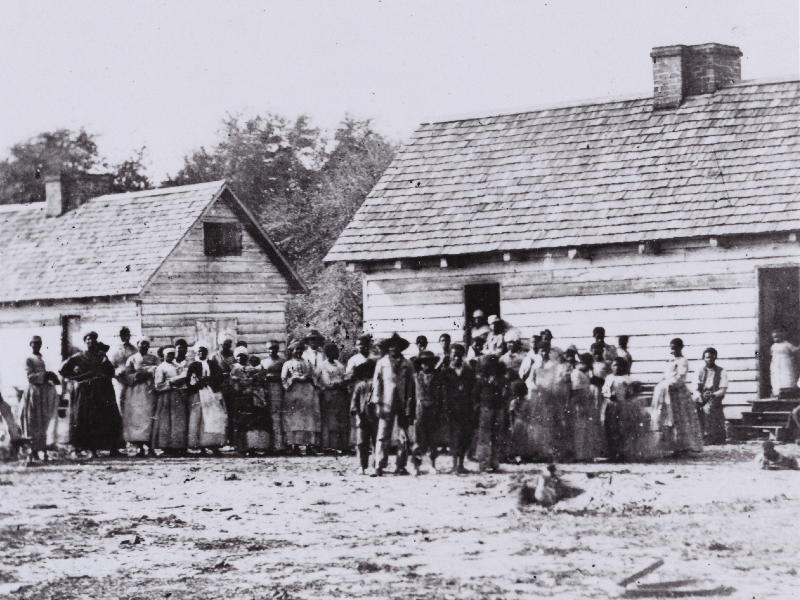
Enslaved African Americans on Smith’s Plantation, Beaufort, South Carolina
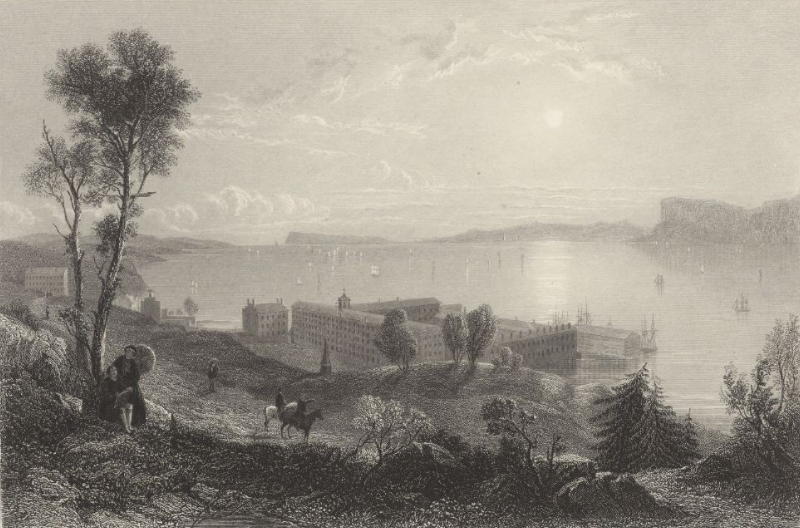
Sing Sing Prison, New York (Houghton Library, Harvard University.
Purchased with the William Inglis Morse Fund, 1943)
Reformer
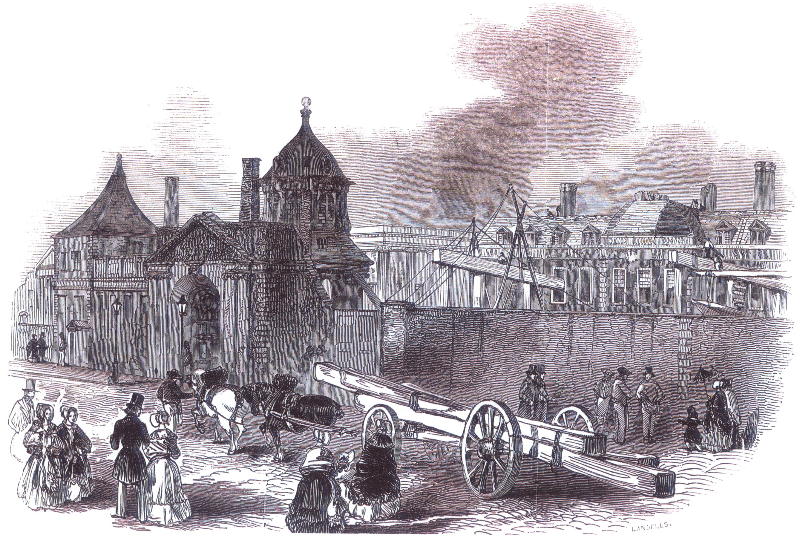
The British Museum under construction, 1845 (Illustrated London News)
In Europe, where industrialization was more advanced than in the U.S., Fuller hoped to find successful models of communities and institutions to prevent the expansion of poverty back home. During this time of steamships, railroads, telegraphs, and booming emigration to American cities, Judith Mattson Bean and Joel Myerson explain, “She envisions American culture as receiving not only people but seeds of thought and expression from other nations.” These “thoughts” could be cultural as well as social and political.
In Liverpool and Manchester, England, Fuller went to Mechanics Institutes where anyone (male or female) with 5 shillings could attend lectures, take courses, or see art exhibitions. In London, she reported on cultural and literary goings-on. In Paris, when she visited homes, hospitals, and day care centers for the sick children of the poor, she observed evening schools where boys were taught a trade. In her dispatches to the New-York Tribune, she recommended that America immediately adopt such measures.
But it was the urban poverty of the slums that affected Fuller most of all, and the clear need for reform. In a dispatch from France she wrote, “The need of some radical measures of reform is not less strongly felt in France than elsewhere, and the time will come before long when such will be imperatively demanded.”
She also wrote, “To themselves be woe, who have eyes and see not, ears and hear not, the convulsions and sobs of injured Humanity.”
Two questions plagued Fuller’s mind: What was her role in what she was witnessing? What was America’s role?
As Joan von Mehren points out, after visiting Paris, “Every one of her columns now made some plea on behalf of its ‘injured Humanity.’” While the initial purpose of Fuller’s journey to Europe was “to seek useful ideas to transplant to the new world,” she was transformed by her experience into “a radical vocation to communicate the monstrous suffering and human waste of the historical movement.”
If there was any doubt in Fuller’s mind about her stature as an international voice, there was no doubt in the minds of her new European friends. Fuller’s reputation preceded her. They seemed to know she was destined to bridge the two continents and promote the reforms that were in their mutual interest. They embraced her.
In England, she renewed her acquaintance with social commentator Harriet Martineau, met the poet William Wordsworth, and the co-editors of the People’s Journal Mary and William Howitt (whose modern marriage she had described in Woman in the Nineteenth Century). She also met Giuseppe Mazzini, the legendary exiled Italian revolutionary about whom Fuller had written for the Tribune. She was drawn to his cause and became his confidante and secret messenger.
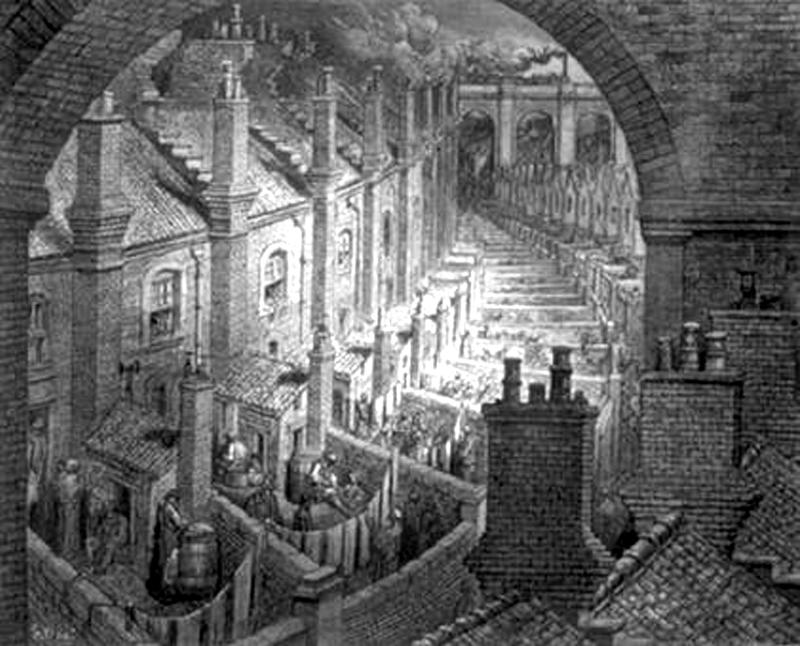
London slums, 1856
In Paris, Fuller met George Sand and Pierre Leroux, who invited her to publish work in their periodical La Revue Indépendante. She was introduced to the exiled Polish revolutionary and poet Adam Mickiewicz, who became a kind of spiritual guide.
Fuller was in her element, filled with a sense of purpose and armed with the skills and mechanism (the Tribune) to make a difference. But the best was yet to come—Italy.
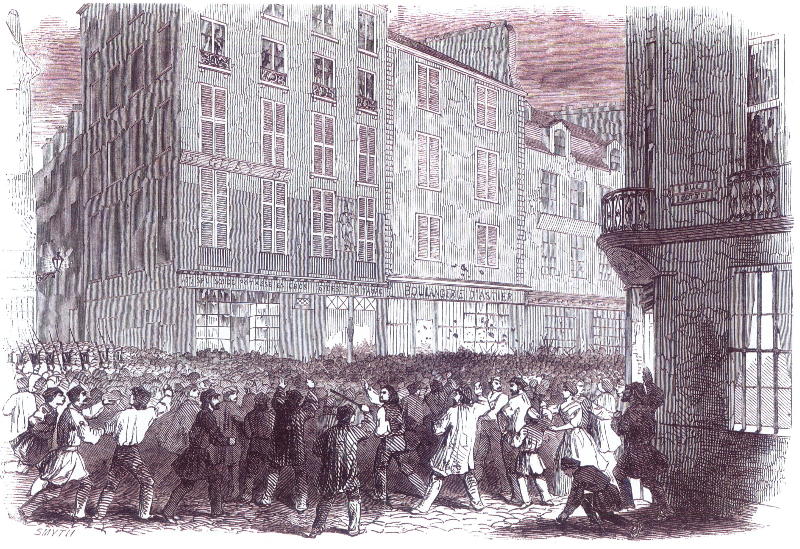
Bread Riot in the Rue du Fauborg St. Antoine, Paris, 1846 (Illustrated London News)

The Pont Neuf, Paris, 1845
Revolutionary
Margaret Fuller arrived in Italy in March 1847, carrying secret letters from the Italian revolutionary Giuseppe Mazzini and knowing she was heading into a turbulent political situation. What Mazzini and his supporters hoped to forge was a united Italian Republic starting with Rome, where the new Pope, Pius IX, seemed open to reform. The revolutionaries wanted to limit the Pope’s power to spiritual matters; secular matters, like governance, should be left to democratically elected officials. With Rome as the head of a new republic, the rest of the independent states comprising Italy could join and form one democratic nation. Austrian and French forces, in particular, had other ideas. So did the Pope, whom Fuller took on in one of her more gutsy dispatches to the New-York Tribune, her employer.
Among Mazzini’s supporters was the Marchese Giovanni Angelo Ossoli, the youngest son of an aristocratic Catholic family with ties to the Pope. Fuller fell in love with him, and gave birth to their child, Angelo Eugene Phillip Ossoli (“Nino”) in 1848 in Reiti, where she had temporarily relocated for their safety. She returned to Rome as soon as she found caretakers for Nino, and resumed her work as the first woman foreign correspondent for a major newspaper to serve in wartime.
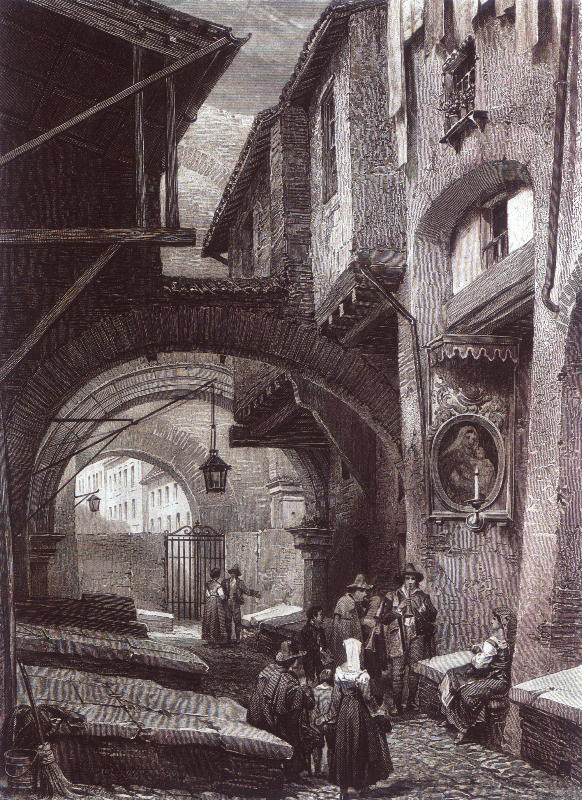 “[K]ings may find their thrones rather crumbling than tumbling;
“[K]ings may find their thrones rather crumbling than tumbling;
the priests may see the consecration wafer turn into bread to
sustain the perishing millions even in their astonished hands.
God grant it. Here lie my hopes now. I believed before I came
to Europe in what is called Socialism, as the inevitable sequence
to the tendencies and wants of the era, but I did not think these
vast changes in modes of government, education and daily life,
would be effected as rapidly as I now think they will, because they
must. The world can no longer stand without them.”
—Margaret Fuller, 1850
Fuller observed the Roman Revolution first-hand, managed a hospital, assisted her husband on the front lines, and began to write a modern history of the movement. In one of her last dispatches from Rome she wrote, “The New Era is no longer an embryo; it is born; it begins to walk—this very year sees its first giant steps, and can no longer mistake its features. Men have long been talking of a transition state—it is over—the power of positive, determinate efforts is begun.” However, Fuller did not believe republican forms of government would take hold in Europe until the next century, and she was right.
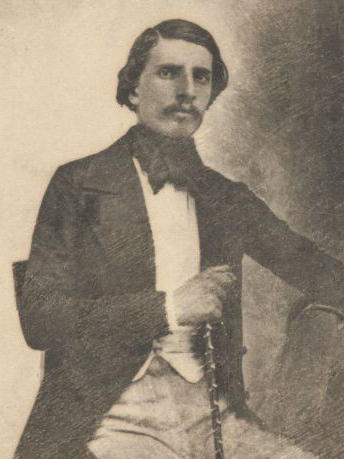 “Giovanni Angelo Ossoli
“Giovanni Angelo Ossoli
(Houghton Library,
Harvard University.
Bequest of Edith D. Fuller)
I have wished to be natural and true, but the world was not in harmony with me—nothing came right for me. I think the spirit that governs the Universe must have in reserve for me a sphere where I can develop more freely, and be happier.” —Margaret Fuller
The Ossolis (Fuller began to refer to herself as the Countess Ossoli and assured her friends they had married) escaped from Rome in 1850 as the revolution fell apart. Although she had a nightmare about the voyage and wrote to friends that she had a terrible sense of foreboding, the family eventually sailed for New York where Fuller knew she could find a publisher for her history.
It was an awful journey. The captain died of cholera on the way which Nino, her baby, also contracted. Before the steamer Elizabeth could reach its destination, and under the direction of a less experienced captain, a storm crossed its path, the ship ran aground, and eventually capsized just off Fire Island, New York. Some passengers were rescued, while others waited for help. Onlookers looted the items that washed ashore.
All three Ossolis perished at sea, along with Margaret’s manuscript of the Roman Revolution. Only Nino’s body was recovered, and he was buried in the Fuller family plot at Mount Auburn Cemetery in Cambridge, Massachusetts, where a cenotaph in Margaret Fuller Ossoli’s memory now stands.
In a plea to her American audience from Rome, Fuller had written, “I pray you do something; let [the revolution] not end in a mere cry of sentiment … Do you owe no tithe to heaven for the privileges it has showered on you, for whose achievements so many here suffer and perish daily? Deserve to retain them by helping your fellow-men to acquire them … Friends, countrymen, and lovers of virtue, lovers of freedom, lovers of truth!—be on the alert; rest not supine in your easier lives, but remember
‘Mankind is one And beats with one great heart.’”
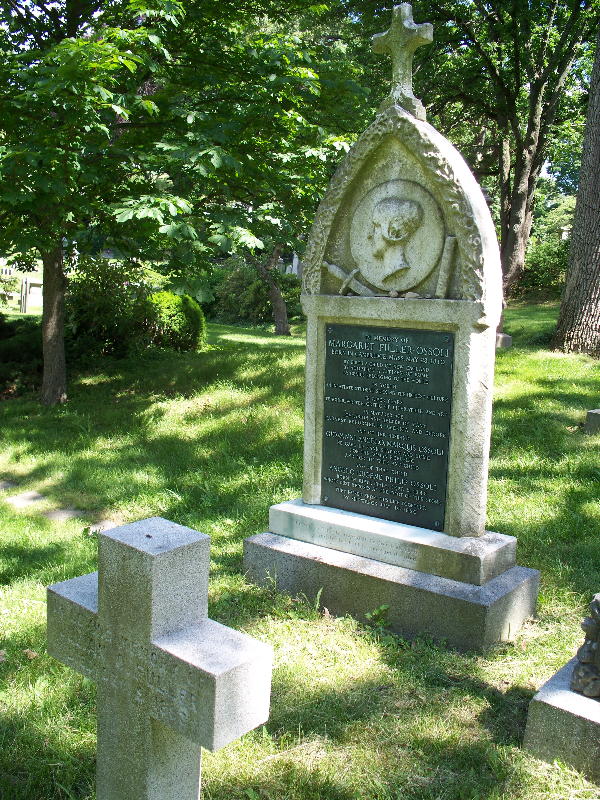
Fuller Ossoli, Mount
Auburn Cemetery,
Cambridge,
Massachusetts.
The inscription:
“Born a child of
New England,
By adoption a
citizen of Rome,
By genius belonging
to the World”
Tributes
"Higher natures like hers, living for higher aims, have a more evident Providence managing their destiny, & it was manifest that she was not to come back to struggle against poverty, misrepresentation, & perhaps alienated friendships and chilled affections. There seemed no position for her here, & her life was complete, so far as experience & development went. That she shd. have accomplished so little for the public in proportion to her genius & attainments is to us a loss -- but her own aim was rather development than manifestation, & that first aim she perfectly fulfilled. Her life will seem to us now complete & round."
--James Freeman Clarke
"To the last her country proves inhospitable to her; brave, eloquent, subtle, accomplished, devoted, constant soul! If nature availed in America to give birth to many such as she, freedom & honour & letters & art too were safe in this new world."
--Ralph Waldo Emerson
"She is full of all nobleness, and with the generosity native to her mind & character, appears to me an exotic in New England, a foreigner from some more sultry & expansive climate. She is, I suppose, the earliest reader & lover of Goethe, in this country, and nobody here knows him so well. Her love too of whatever is good in French & especially in Italian genius, give her the best title to travel. In short, she is our citizen of the world by quite special diploma."
--Thomas Carlyle
"America has produced no woman who in mental endowments and acquirements has surpassed Margaret Fuller."
--Horace Greeley
"The Conversations were a 'vindication of woman's right to think.'"
--Elizabeth Cady Stanton
"How characteristic are all the things told of Margaret on board, giving her only life-preserver to a sailor to seek for help, when a less sanguine or more selfish person would not have done [so] -- her refusing to part with her child when she could not have saved him...; her securing the money about her showed how much she felt the need of it -- One who had always been taken care of would not have done so when lives were in danger."
--Caroline Sturgis Tappan
"There was ... a fate in her, and was in the struggle against this, that she wrought her greatest victories. I think her courage surpassed by no woman I have met. It made her life one of the revolutions, and brought her to the tragic end."
--Bronson Alcott
"To her, I, at least, had hoped to confide the leadership of this movement. It can never be known if she would have accepted it...; she was, and still is a leader of thought; a position far more desirable than a leader of numbers."
--Paulina Wright Davis, president, Woman's Rights Convention, Worcester, Massachusetts, 1850; the convention observed a moment of silence in her memory before proceeding
"She was not framed by nature for a mystic, a dreamer, or a bookworm ... but a career of mingled thought and action, such as she finally found."
--Thomas Wentworth Higginson
"For as long as she lived, and afterward too, almost everyone who knew Fuller well groped for words when they tried to describe her; nearly all of them were compelled, sooner or later, to use the word 'force.'"
--Joan von Mehren, biographer
Body of Work
"She gave a national dimension to the role of the literary critic, bringing to it a political and social conscience that has been the hallmark of its best practitioners ever since."
--Joan von Mehren
"Responding to literature and the social problems of the 1840s, she gained the power of self-expression and chose positions that made her an articulate critic of American and European culture."
--Judith Mattson Bean and Joel Myserson
"Most distinctive was her voice: politically savvy, culturally alert, and electrically charged by a vibrant intellectual personality grappling with one of her deepest conundrums--her identity as an American cosmopolitan liberal--resounding off the screen of the greatest European political cataclysm of the nineteenth century."
--Charles Capper
Articles
 Literary criticism
Literary criticism- American Monthly Magazine
- Boston Daily Advertiser and Patriot
- Boston Quarterly Review
- The Dial
- La Revue Indépendante
- Present, the Spirit of the Age
- New-York Tribune
- Western Messenger
Cultural commentary
- The Dial
- New-York Tribune
Biographical sketches
- The Dial
- New-York Tribune
Social commentary
- The Dial
- New-York Tribune
- United States Magazine and Democratic Review
Translations
- Published privately by Elizabeth Peabody
- Western Messenger
Books
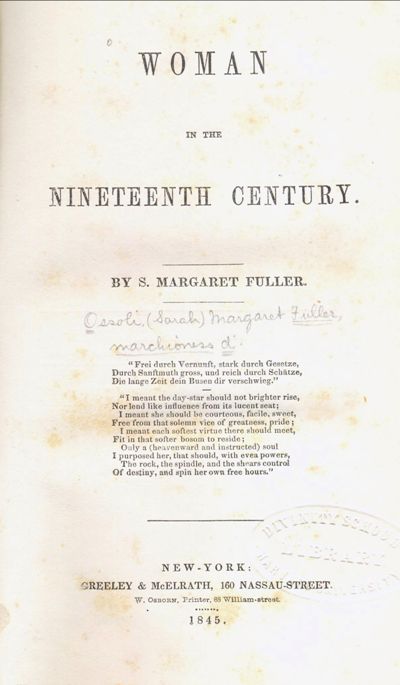 "Conversations with Goethe in the Last Years of His Life," (published by Hilliard, Gray and Company, Boston, as part of George Ripley's Specimens of Foreign Standard Literature series, 1839)
"Conversations with Goethe in the Last Years of His Life," (published by Hilliard, Gray and Company, Boston, as part of George Ripley's Specimens of Foreign Standard Literature series, 1839)
Summer on the Lakes, in 1843 (Little and Brown, Boston, 1844)
Woman in the Nineteenth Century (Greeley and McElrath, 1845)
Papers on Literature and Art (Wiley and Putnam, New York, 1846)
A Modern History of the Roman Republic (actual title unknown, manuscript lost at sea)
Published Posthumously
Memoirs of Margaret Fuller Ossoli (prepared by William Henry Channing, James Freeman Clarke, Ralph Waldo Emerson, published in 1852 by Phillips, Sampson and Company in Boston; the best selling biography of the 1850s; by the end of the century, there were 13 editions including one in German)
Woman in the Nineteenth Century and Kindred Papers (prepared by Arthur Fuller, published in 1855 by John P. Jewitt, Boston)
At Home and Abroad
(a compilation of Tribune articles and letters written from abroad; compiled by Arthur Fuller, published in 1856 by Crosby, Nichols, and Company, Boston)
Life Within and Without
(Dial and Tribune articles written in New York; compiled by Arthur Fuller, published in 1860 by Brown, Taggard, and Chase, Boston)
Fuller quote:
"I felt a delightful glow as if I had put a good deal of my true life in it, as if, suppose I went away now, the measure of my foot-print would be left on the earth."
--Margaret Fuller, on completing Woman in the Nineteenth Century
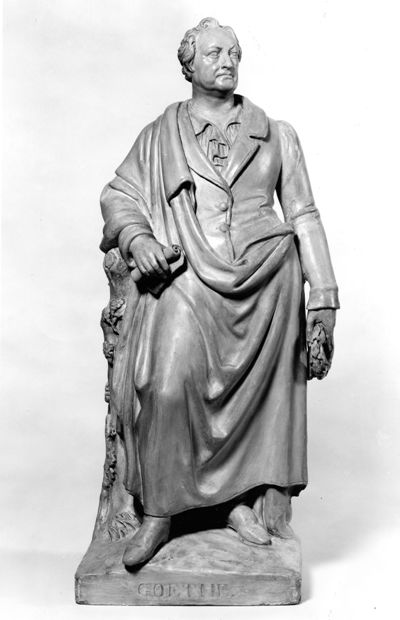 Johann Wolfgang von
Johann Wolfgang von
Goethe, whose influence
on Fuller and the American
Transcendentalists was
profound; Fuller’s biography
of him brought her acclaim
and stature (National
Park Service, Longfellow
National Historic Site )
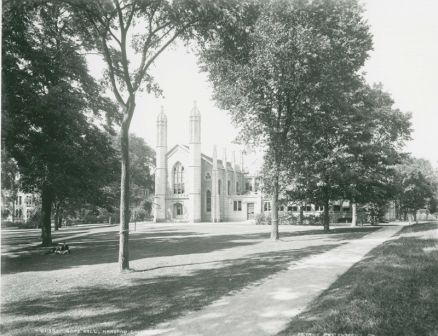
Gore Hall, Harvard College Library; Margaret Fuller was the
first woman allowed to use Harvard’s library for her own research
(Cambridge Historical Commission)
Friends
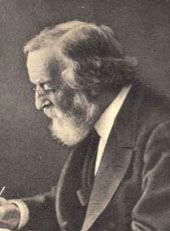 James Freeman Clarke
James Freeman Clarke
Fuller met Clarke while he was a student at Harvard studying for the Unitarian ministry. He became part of the circle she gathered around her as a young woman in Cambridge. Clarke published some of Fuller’s earliest work in the Western Messenger, a periodical he started in 1835. (Photo: Andover-Harvard Theological Library)
William Henry Channing
The nephew of William Ellery Channing, William Henry was a Harvard-trained Transcendentalist Unitarian minister. He was a prolific writer for the Dial, and the editor of the socialist periodical Present to which Fuller contributed. Channing was an Associationist, a movement that married socialism with Christianity.
Lydia Maria Francis Child
One of Boston’s foremost abolitionists and Unitarians, Child was the author of America’s first anti-slavery book. She tutored young Margaret at the Francis home in Watertown, Massachusetts, and later continued their friendship in Boston and New York where Child edited the National Anti-Slavery Standard.
Ralph Waldo Emerson
Considered the leader of the American Transcendentalist movement, Emerson was an author, philosopher, lecturer, former Unitarian minister, and founder of the Dial, which he asked Fuller to edit. Fuller first met Emerson at his home in Concord, Massachusetts, where many Transcendentalists gathered at the informal “Concord University.” Their relationship is the subject of much study. He was an early mentor and friend, but Fuller exerted her independence of thought.
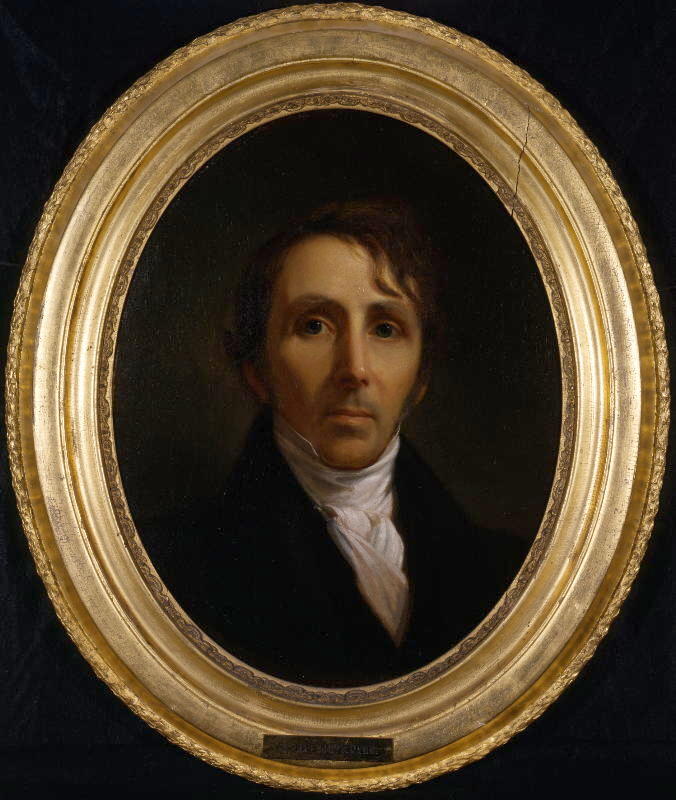 William Ellery Channing
William Ellery Channing
As the leading Unitarian minister in Boston and the nation, Channing was a central figure in the lives of Fuller and her Transcendentalist friends. As the historian Frank Carpenter explains, “Channing fervently believed God had made human nature, with its capacity for moral choice and ever increasing understanding, akin to the divine. He confidently preached the possibility of unending moral and spiritual progress for all who would shape their lives in accordance with its demands.” As a young woman, Fuller worked for Channing as a reader and translator and she attended his Federal Street Church. Channing’s nephew, Ellery, married Fuller’s sister Ellen. (Photo: Imaging Department © President and Fellows of Harvard College)
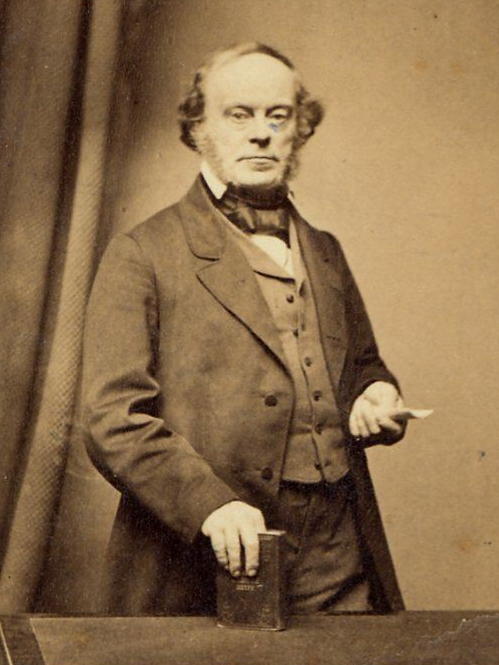 Frederic Henry Hedge
Frederic Henry Hedge
Hedge and Fuller became friends while he was studying for the Unitarian ministry at Harvard. Hedge was also an author, and part of the Emerson group in Concord where he founded what would become the Transcendentalist Club. Fuller was invited to join the club, which was the first time women were allowed as members of a leading male intellectual society. Hedge served on the faculty at Harvard and edited The Christian Examiner. (Photo: Andover-Harvard Theological Library)
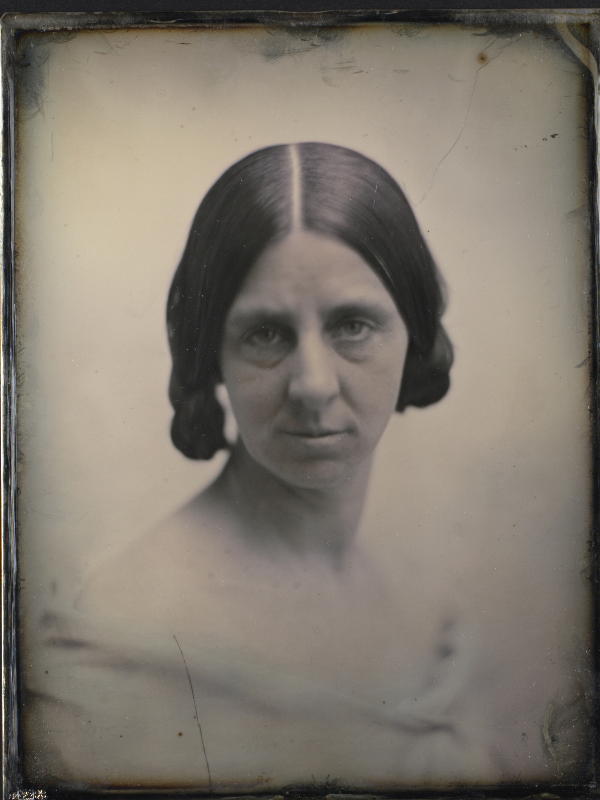 Caroline Sturgis Tappan
Caroline Sturgis Tappan
Transcendentalist, poet, and children’s author, Caroline Sturgis was one of Fuller’s closest friends and part of the Concord group. During Fuller’s period of homelessness, they traveled together. Tappan attended Fuller’s Conversations, and contributed to the Dial. (Photo: George Eastman House, International Museum of Photography and Film)
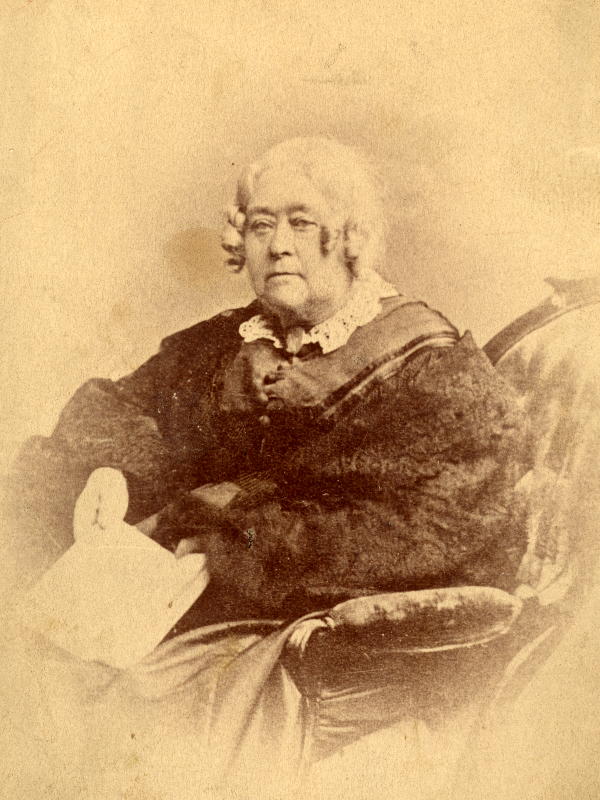 Elizabeth Peabody
Elizabeth Peabody
Peabody’s bookstore on West Street in Boston was the site of Fuller’s Conversations, which Peabody attended along with her sisters Mary and Sophia. Peabody taught at Bronson Alcott’s Temple School and founded the kindergarten movement in America. She was an author and the first woman publisher in Boston. (Photo: Concord Free Public Library)
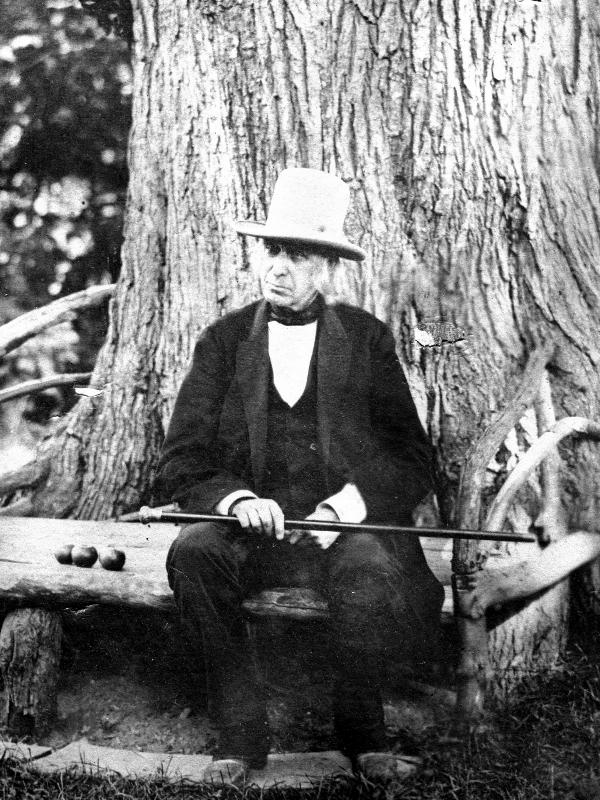 Bronson Alcott
Bronson Alcott
Fuller met the educator, philosopher, and Transcendentalist in Concord in 1836 and moved to Boston to teach at his controversial Temple School. Alcott’s discussions of sexually explicit subjects, reinterpretations of the Gospel, and acceptance of an African American student caused the school to close in 1837. Alcott later helped found the failed utopian community Fruitlands in Harvard, Massachusetts. (Photo: Concord Free Public Library)
Hiram Fuller
Hiram Fuller (no relation) hired Fuller for an impressive salary to teach at his Greene Street School in Providence, Rhode Island, in 1837. There, with her students, Fuller really blossomed as a teacher and first examined female culture. She gave her first public speech on the subject at the intellectual Coliseum Club. Hiram Fuller was a follower of Bronson Alcott, applying many of Alcott’s child-centered methods to his own school.
Horace Greeley
Greeley noticed Fuller’s bold writing in the Dial and hired her for his reformist Whig newspaper, the New-York Tribune, making Fuller the first woman to head the literary department of a major American newspaper. Fuller established herself as a leading public voice for social and political reform. When Greeley published her writings from Europe, Fuller became the first woman correspondent and the first woman journalist to serve during wartime for a major American newspaper. Greeley published Fuller’s most famous work, Woman in the Nineteenth Century.
Harriet Martineau
Fuller first met Martineau in Cambridge, Massachusetts, while the celebrated and outspoken British journalist, philosopher, and social commentator was touring the United States. While Martineau was somewhat critical of Fuller’s book Woman in the Nineteenth Century, and Fuller took issue with Martineau’s book Society in America, the two women resumed their friendship while Fuller was in England.
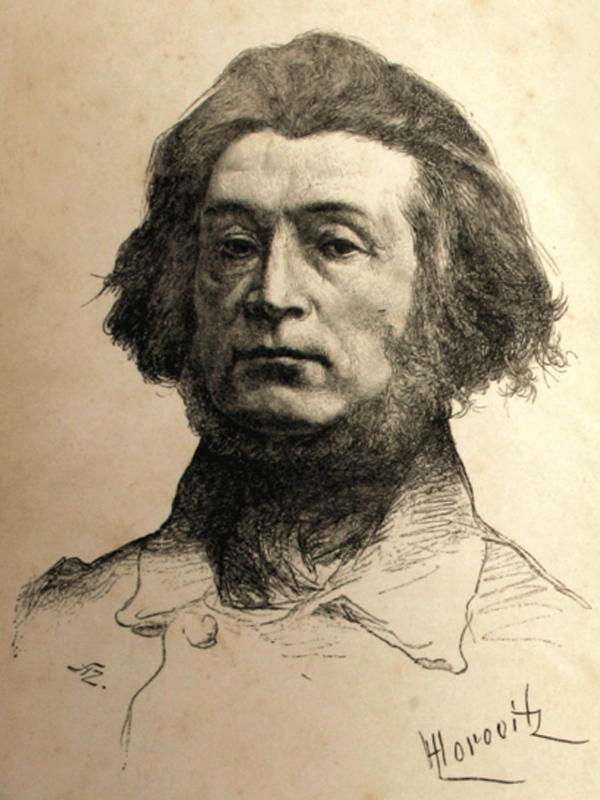 Adam Mickiewicz
Adam Mickiewicz
Poet, preacher, and exiled Polish revolutionary, Fuller met Mickiewicz in England and he became a kind of spiritual guide to her. He encouraged her to lead a more balanced life, professionally and spiritually. According to Joan von Mehren, Mickiewicz told her that in Europe “Her soul would find its sustenance in the Old World, its ‘activity’ in the New World, and its ‘repose’ in the future world.” Fuller agreed.
Thomas Carlyle
A Scottish essayist, historian, and reformist, Carlyle was drawn to the works of Goethe and other German philosophers, which led to his affinity with the American Transcendentalists and Ralph Waldo Emerson. Fuller encountered the German philosophers through Carlyle’s writing in the Edinburgh Review, and met him in 1846 in London. Carlyle threw a literary party for Fuller, introducing her to the finest writers of literary London.
George Sand
Born Amandine Aurore Lucile Dupin, Sand was a native of Paris who divorced her husband, kept her children, and became France’s first female novelist using a male pen name. She wore men’s clothes, smoked cigars, had affairs (most famously with the composer Frederic Chopin) and challenged social conventions that inhibited women. Fuller met Sand in Paris in 1846 at the height of Sand’s literary fame.
Giuseppe Mazzini
Fuller met the great exiled Italian revolutionary in London in 1846, and she was drawn to his efforts to transform Italy into a modern republic. Mazzini trusted Fuller to carry secret letters with her from Rome, where she became actively involved in the Roman Revolution as a correspondent for the New-York Tribune, manager of a hospital, and the author of a history of the revolution.
Giovanni Angelo Ossoli
Fuller became involved with Ossoli in 1847. The following year, she gave birth to their son, Angelo Eugene Phillip Ossoli. Ossoli, a revolutionary, was the estranged son of a Catholic noble family with ties to the Pope. He was ten years Fuller’s junior, and although a marriage certificate has never been found Fuller left behind letters suggesting a legal arrangement and she called herself the Countess Ossoli.
Review of May 12, 2010 event: Margaret Fuller Reporting for the New York Tribune (New York, NY)
Following is a summary of an event at City Hall Park in New York City by the Horace Greeley Statue by Michael Barnett, the event organizer and speaker. Photo taken by Ted Hallman.
Michael Barnett Speaks on Margaret Fuller's Reporting for the New York Tribune at Horace Greeley's Statue at City Hall Park, Manhattan.
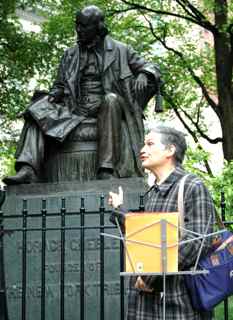
On a damp, drizzly Wednesday, May 12, 2010, theologian and educator Michael Barnett stood near the Horace Greeley statue in City Hall Park to share Margaret Fuller's insightful and provocative reporting for the New York Tribune during her Bicentennial.
For four hours, Michael received many "thumbs-ups," notable "thank-yous" and "keep up the good work" acknowledgements as well as a few of the typical New Yorker "crazy person on the street speaking" and "just ignore him completely" attitudes from hundreds of Manhattan passersby.
One earnest and interested passerby stood swept by emotion as Michael shared his ode to Margaret Fuller. Another man from the Bronx talked with my friend Ted and me for a long time about Margaret Fuller. He is interested in installing Margaret into the New York Hall of Fame for her accomplishments.
It was worthwhile taking Margaret Fuller to the steps of City Hall where Horace Greeley looks toward the location of his New York Tribune building on Newspaper Row.
My $25.00 New York City Parks and Recreation permit allowed me to speak on MF for these four hours at the site of her boss's statue.
Review of May 22, 2010 event: Panel Discussion (Concord, MA)
Michael Barnett, a participant in the First Parish in Concord's bicentennial celebrations, has submitted the following descriptions of his weekend in Concord and participation on the panel discussion on May 22, 2010. Photos at the end were taken by Ted Hallman.
"I was invited to be part of the panel discussion for Margaret Fuller's 200th Birthday Weekend Celebration at First Parish in Concord, MA, from May 20 through 23.
My partner, Ted Hallman, and I were given beautiful hospitality by Sara and Stoney Ballard who are very active members at First Parish. On Friday, May, 21, Sara took Ted and me to Mount Auburn Cemetery to see Margaret Fuller's memorial.
On May 22, at 10 am, I participated in a panel discussion on Margaret Fuller with Joan von Mehren and Brigitte Bailey led by Reverend Jenny Rankin of First Parish. The social hall was packed with an excellent turnout!
It was lovely to be part of this panel discussion and celebration."
--Michael Barnett
May 22, 2010 panel in Concord:
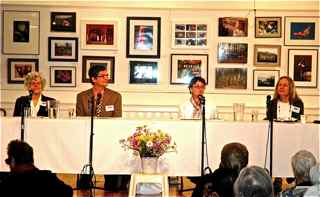
Pictured: Panelists Joan von Mehren and Michael Barnett
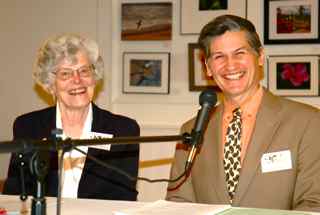
Pictured left to right: Joan von Mehren, Michael Barnett, Rev. Jenny Rankin and Prof. Brigitte Bailey.
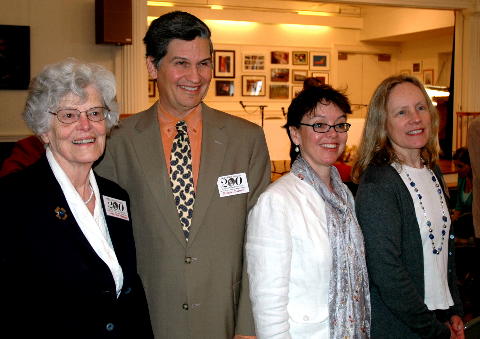
Memorial Service At Mount Auburn Cemetery

MEMORIAL SERVICE CELEBRATES LIFE OF MARGARET FULLER OSSOLI
Wreath Laying Ceremony at Mount Auburn Cemetery
Sunday July 18th, 2010, 12:30 P.M.
Cambridge, MA, June 25, 2010 – A commemoration of the life and legacy of author, reformer and Transcendentalist, Margaret Fuller Ossoli, takes place Sunday July 18th at Mount Auburn Cemetery, 580 Mount Auburn Street, Cambridge MA. Actors will appear in costume to pay tribute to this significant woman. The doors of Mount Auburn’s Bigelow Chapel will open for a reception at 12:30. Bree Harvey, Director of Education and Visitor Services for the cemetery, will welcome guests promptly at 1:00 P.M. Rev. Rosemarie Smurzynski will lead the Memorial Service and Eric Huenneke will provide the music. After the service, participants will walk to the Fuller family lot for a wreath-laying ceremony at 2:00 PM.
In a brief forty years, Margaret Fuller left a dramatic and lasting legacy. She died tragically when the ship carrying her, her husband, and their young son, sank off the coast of New York’s Fire Island. Though a memorial in her memory was erected in the Fuller family lot at the cemetery, historical evidence suggests that a memorial service to celebrate her life was never held. The July 18th celebration will allow people to pay a much belated tribute to this groundbreaking icon.
The actors participating in the program are as follows: Jessa Piaia as Margaret Fuller, Wendell Refior as Ralph Waldo Emerson, Rob Velella as James Freeman Clarke, Dorothy Emerson as Elizabeth Peabody, Richard Smith as Henry David Thoreau, and Deborah Goss as Julia Ward Howe.
This event is part of the Bicentennial’s Conversations Series, supported by a grant from Mass Humanities and modeled after the “Conversations” Margaret Fuller offered for women (and later men) in Boston in the late 1830s and early 1840s. The event is co-sponsored by the Margaret Fuller Bicentennial Committee and the Friends of Mount Auburn and is part of a year-long series of events celebrating Margaret Fuller’s life and work. This event is FREE and open to the public.
Theatre@First Revives The Margaret Ghost
FOR IMMEDIATE RELEASE
PRESS CONTACT: Beckie Hunter
tel: 617 669 4387
email: info@theatreatfirst.org
www.theatreatfirst.org
THEATRE@FIRST REVIVES THE MARGARET GHOST
Witty, romantic play celebrates Margaret Fuller Bicentennial
Theatre@First presents a one-weekend revival of the successful 2006 production of local playwright Carole Braverman’s The Margaret Ghost, in honor of the 200th anniversary of main character Margaret Fuller’s birth. Performances June 17-20, 2010 in the beautiful new theatre at The First Church in Belmont, 404 Concord Ave., Belmont, MA. Tickets are available through www.theatreafirst.org.
On June 19th at 6:30pm the public is invited to a special Gala Performance. A wine reception will be followed by a conversation with playwright Carole Braverman and director Elizabeth Hunter in the tradition of Margaret Fuller’s Conversations for the Women of Boston. The performance starts at 8pm and both of these talented women will be available during intermissions to answer questions. After the show, the audience will have the opportunity to meet the actors portraying Fuller and her contemporaries, including Ralph Waldo Emerson and Nathaniel Hawthorne.
The Margaret Ghost is a witty, engaging look at the struggles of a woman too intelligent to fit into the narrow role of a nineteenth-century woman, and too passionate to settle for less than the full human experience. From the parlors of Cambridge to the streets of Rome, The Margaret Ghost follows Fuller as she searches for truth, beauty and love amid the tides of history.
Carole Braverman’s plays have been produced in New York, London, Boston, San Francisco, Los Angeles, and various other venues. The Yiddish Trojan Woman won London Weekend Television’s “Plays on Stage” award and has been published by Dramatists Play Service, and in anthology. The Margaret Ghost was originally produced by the Berkeley Repertory Theater, where Braverman was Playwright in Residence from 1983–85. In addition to writing plays, Braverman taught English at Phillips Academy in Andover for 27 years.
Theatre@First is Somerville’s largest community theatre and has filled a vital role in the vibrant Davis Square arts community since its founding in 2003. For more information about Theatre@First visit www.theatreatfirst.org.
The Margaret Ghost is just one of a year-long series of events celebrating the Margaret Fuller Bicentennial. For a full listing of events visit www.margaretfuller.org.
|
FOUR PERFORMANCES ONLY! |
FOR TICKETS/INFO: |
|
Thursday, June 17, 8pm |
www. theatreafirst.org |
|
Friday, June 18, 8pm |
or call 1-888-874-7554 |
|
GALA - Saturday, June 19, 6:30pm reception; 8pm performance MATINEE - Sunday, June 20, 3pm |
LOCATION: The First Church in Belmont, UU 4040 Concord Ave, Belmont, MA |
|
|
|
|
|
|
Subcategories
News
Select a news topic from the list below, then select a news article to read.

